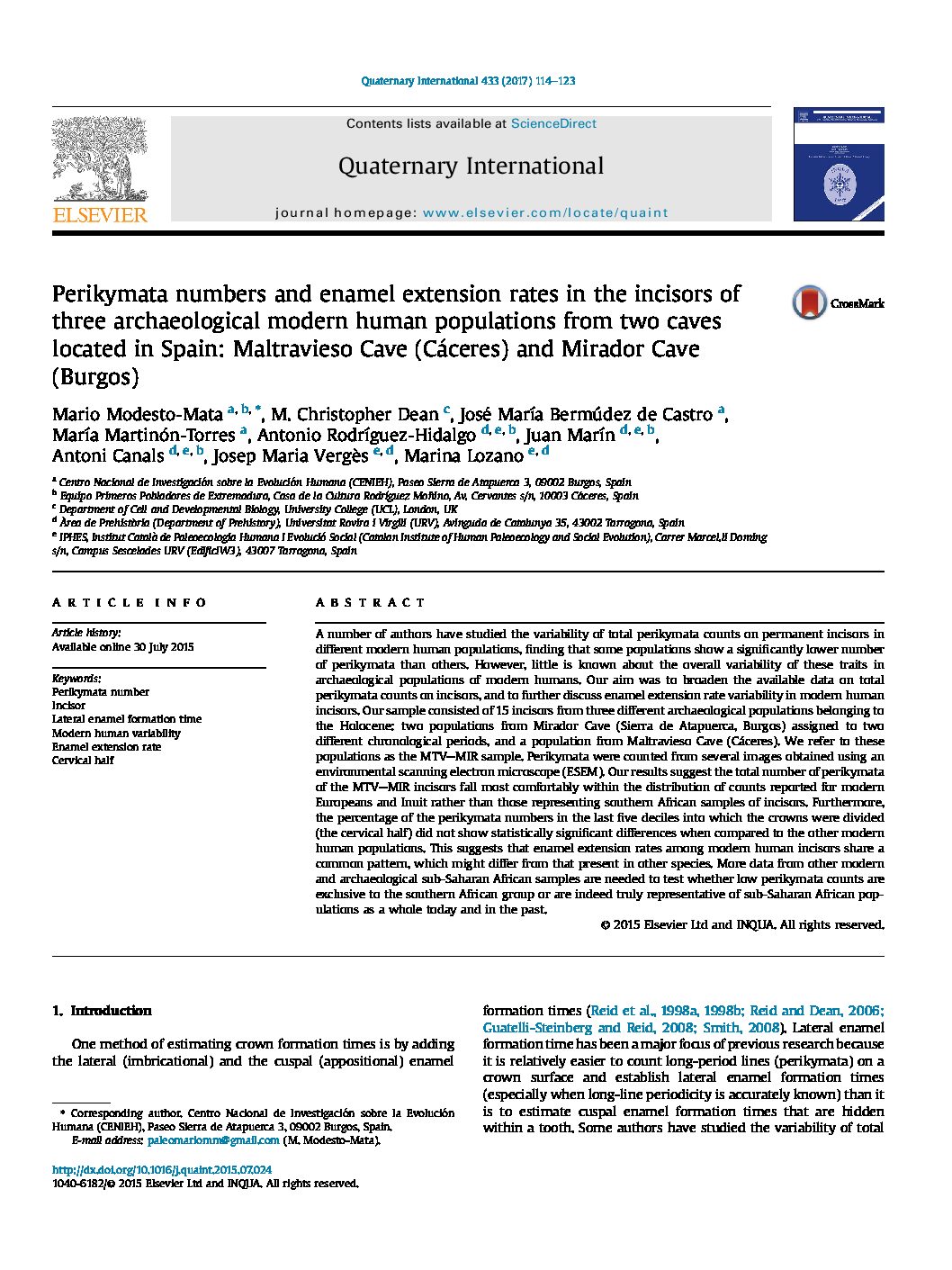Canals, Antoni
New methodology to reconstruct in 2-D the cuspal enamel of modern human lower molars
Objectives In the last years different methodologies have been developed to reconstruct worn teeth. In this article, we propose a new 2-D methodology to reconstruct the worn enamel of lower molars. Our main goals are to reconstruct molars with a high level of accuracy when measuring relevant histological variables and to validate the methodology calculating the errors associated with the measurements. Methods This methodology is based on polynomial regression equations, and has been validated using two different dental variables: cuspal enamel thickness and crown height of the protoconid. In order to perform the validation process, simulated worn modern human molars were employed. The associated errors of the measurements were also estimated applying methodologies previously proposed by other authors. Results The mean percentage error estimated in reconstructed molars for these two variables in comparison with their own real values is −2.17% for the cuspal enamel thickness of the protoconid and −3.18% for the crown height of the protoconid. This error significantly improves the results of other methodologies, both in the interobserver error and in the accuracy of the measurements. Conclusions The new methodology based on polynomial regressions can be confidently applied to the reconstruction of cuspal enamel of lower molars, as it improves the accuracy of the measurements and reduces the interobserver error. The present study shows that it is important to validate all methodologies in order to know the associated errors. This new methodology can be easily exportable to other modern human populations, the human fossil record and forensic sciences.
Perikymata numbers and enamel extension rates in the incisors of three archaeological modern human populations from two caves located in Spain: Maltravieso Cave (Cáceres) and Mirador Cave (Burgos)
A number of authors have studied the variability of total perikymata counts on permanent incisors in different modern human populations, finding that some populations show a significantly lower number of perikymata than others. However, little is known about the overall variability of these traits in archaeological populations of modern humans. Our aim was to broaden the available data on total perikymata counts on incisors, and to further discuss enamel extension rate variability in modern human incisors. Our sample consisted of 15 incisors from three different archaeological populations belonging to the Holocene: two populations from Mirador Cave (Sierra de Atapuerca, Burgos) assigned to two different chronological periods, and a population from Maltravieso Cave (Cáceres). We refer to these populations as the MTV–MIR sample. Perikymata were counted from several images obtained using an environmental scanning electron microscope (ESEM). Our results suggest the total number of perikymata of the MTV–MIR incisors fall most comfortably within the distribution of counts reported for modern Europeans and Inuit rather than those representing southern African samples of incisors. Furthermore, the percentage of the perikymata numbers in the last five deciles into which the crowns were divided (the cervical half) did not show statistically significant differences when compared to the other modern human populations. This suggests that enamel extension rates among modern human incisors share a common pattern, which might differ from that present in other species. More data from other modern and archaeological sub-Saharan African samples are needed to test whether low perikymata counts are exclusive to the southern African group or are indeed truly representative of sub-Saharan African populations as a whole today and in the past.
Level TE9c of Sima del Elefante (Sierra de Atapuerca, Spain): A comprehensive approach
Level TE9c of the Sima del Elefante site (Sierra de Atapuerca, Spain) is one of the oldest sites with evidence of human occupation in western Europe. We began excavating level TE9c in 2003, and the work there continues today. The studies of the archaeology, palaeontology and geology from this locality have provided an indispensable dataset with which to capture a picture in the scenario of the origin of humans in Europe. Based on these data, we raise and discuss several topics, such as the possible origin of the lineage of the first hominins that inhabited western Europe; their capacity to have active hunting or scavenging abilities; whether their subsistence strategies were successful; and what the environment and habitats where these hominin groups settled was like. The aim of this paper is to present the results and discussions obtained from the research team and to establish the primary features of early human occupations in southwestern Europe. Tentatively, we may conclude, based on the events recorded at TE9c, that the first humans were in the Iberian peninsula at around 1.2 Ma they used the caves of the Sierra de Atapuerca as shelters probably during their hunting activities; the cavities were surrounded by Mediterranean forest, rivers and water ponds, and varied habitats as suggested by the rich and diverse assemblage of fossils of vertebrates (fish, amphibians and reptiles, birds, large and small mammals); where humans possibly caught what they found in the surroundings.



